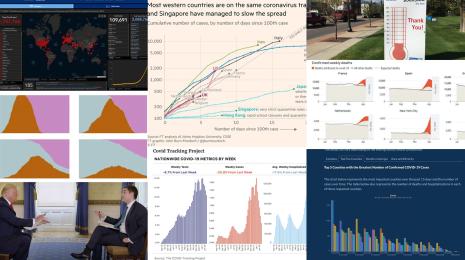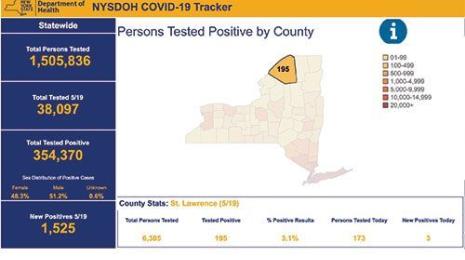Data-driven executives share advice on tackling a new business reality
Editor’s note: Perspectives shared in this post originally appeared in this Forbes virtual event.
Adam Selipsky, Tableau’s President and CEO, recently connected with fellow C-level executives to discuss the value of putting data first in uncertain times and how that influences your leadership mindset while making important, but difficult decisions.
In a 45-minute discussion, Adam and leaders from Tanium, Puppet, and Salesforce shared how their data thinking and their leadership mindset transformed in the pandemic—what accelerated, shifted, or changed as they confronted new, unexpected challenges. Issues that the pandemic—and the resulting acceleration of digital transformation—forced into the forefront include the proliferation of data and analytics; collaboration that accelerates digital and data transformation, business effectiveness and innovation; and data control, balanced with data enablement. While these topics aren’t new, their importance is now reflected by greater prioritization, attention, and resources by more organizations.
Data is our safety net during uncertain times
It’s no surprise to us at Tableau that data has the power to transform business and influence how employees make decisions, ask questions, and seek out new, innovative solutions to problems. What does stand out is how much more leaders relied on data when the pandemic turned the business world upside down.
“2020 proved without a shadow of a doubt, what we already knew, which is that data is completely pervasive, analytics is completely pervasive,” said Adam. “Everybody in 2020 found out, if they didn’t already know, that they had a digital business...and every digital transformation is also a data transformation.”
A common theme among all the panelists was that data has become a crucial safety net. Embracing data enabled companies to stabilize, address customer needs, maintain some operations normalcy, and ultimately survive—hopefully even thrive. “Data became a beacon and a guide,” as Adam said.
Relying on a rich combination of data sources and analytical insights (even if they aren’t what you expect or want), helps leaders understand how the world is shifting. “It gave me confidence on how to guide the company forward, and in the midst of panic, (it gave) our team a sense of comfort because they were grounded in something,” explained Yvonne Wassenaar, CEO of Puppet, an information technology automation company. While no one can guarantee what will happen tomorrow, next week, or in several months, by leaning into data, businesses can avoid being left swirling in the air.
Shifting how work gets done: Accelerating business effectiveness and innovation
The pandemic has shifted how work gets done, the assets people use, and the technologies that support efforts. People have also had to assess how they use data, both individually and at an organizational level.
“This accelerated an organizational shift that many expected could take five or six years into days or weeks,” explained Orion Hindawi, Co-founder and CEO of Tanium, an endpoint security and systems management company. Now, businesses want to and can use their data to understand the past, but more importantly, see what’s happening today and better plan for tomorrow as the world shifts creating new scenarios and challenges.
“We started to think about the different possible futures, and what no-regret moves and playbooks could be used to move quickly as the future unfolds,” shared Yvonne. “This meant a shift from forecasting to a mindset of scenario analysis.” And relying on a combination of data sources gave Puppet and other businesses clarity on changes in the world and how best to react.
Similar to Tanium and Puppet, Christian Leffin, Strategic Customer Advisor, Office of the CEO at Salesforce is thinking about digital transformation, particularly related to the customer experience. He spoke about a transformation continuum—to renovate, transcend, and evolve. Part of the “evolve” mindset is having a plan, a North Star, where leadership collectively commits to revisit business plans and make any necessary changes around strategic projects, their organizational culture, people, and technologies—all under the notion that they should be customer centric.
What might be surprising to some is that you don’t have to rally every single resource. Instead, Christian recommends leaders identify, “What’s the leanest technology stack you need, creating a data-driven mindset, and then having a 360-degree view so there’s hopefully money left over to spend on innovation and experimentation.” When partners, technology vendors, and even customers can come together with one shared vision while collectively relying on good tools and good data, it creates the best experience for everyone and supports continuous business transformation.
Striking a balance between control and enablement
It won’t be surprising if we come out of the pandemic with more organizations both seeing the value and increasingly relying on digitally-driven services that depend on shared data. But with increasing access to data, it's important to be thoughtful in your approach to issues like security, data management, and compliance.
“We’ve seen amazing things happen in our customers around the world when hundreds, thousands, or hundreds of thousands of users are unleashed to grab data to explore it. But governance is extremely important,” said Adam.
As organizations open up data and analytics to more people, perhaps the entire enterprise, they’re getting more advanced in how they approach data governance. They’re seriously thinking about how to reach self-service analytics at scale while ensuring responsible data use—so everyone has the ability to explore existing KPIs, assess how things are changing, and ask critical questions.
This means finding a suitable balance between control and enablement with data. Even within an organization, different data sources and users will fall along different points in the governance spectrum. It's up to your business to understand and examine how the roles, controls, and processes work to enable agility within the limits of what data availability you're willing to offer. No tolerance for risk puts a very low ceiling on creativity and unleashing business potential.
Data helps leaders do great things
For the leaders who wonder how to enable their business and people with data, the group had powerful advice. With a new mindset in this uncertain reality, set a top-down vision with leadership commitment to be data-driven, then find technology solutions, and combine that with a team of employees, partners, vendors, and customers that will help you move the vision forward.
As Adam concluded, it’s key to no longer think of “data as distinct from the people in organizations, but akin and mixed in with them.” Whether that’s your board, your leadership, or anyone supporting the business—from sales to finance, marketing, and IT. Data can and will help your business, your people, your customers, and your ecosystem—as long as you understand how to harness it.
You can hear more from all four executives by listening to the full roundtable recording on Forbes.com. And tune in for other virtual executive panels in this four-part series by Forbes and Tableau because we can all use guidance as we weather the unknowns.
相关故事
Subscribe to our blog
在您的收件箱中获取最新的 Tableau 更新。








